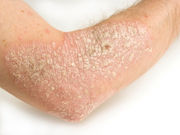Those with psoriasis at higher risk for diabetes, liver disease, elevated lipid levels independent of obesity
THURSDAY, Jan. 11, 2018 (HealthDay News) — Children with psoriasis have an increased risk of comorbidities compared to children without psoriasis, independent of obesity, according to a study published online Jan. 10 in JAMA Dermatology.
Megha M. Tollefson, M.D., from the Mayo Clinic in Rochester, Minn., and colleagues conducted a retrospective cohort study of 29,957 children with psoriasis and an age-, sex-, and race-matched comparator cohort of 29,957 children without psoriasis. The children were divided into nonobese, without psoriasis (reference cohort); nonobese, with psoriasis; obese, without psoriasis; and obese, with psoriasis.
More children with psoriasis were obese at baseline (2.9 versus 1.5 percent). The researchers found that compared to children without psoriasis, those with psoriasis were more likely to develop each of the comorbidities. Even in those without psoriasis, obesity was a strong risk factor for development of each comorbidity (hazard ratios, 2.26 to 18.11). Nonobese children with versus without psoriasis had a risk of comorbidities that was 40 to 75 percent higher: elevated lipid levels (hazard ratio, 1.42), hypertension (hazard ratio, 1.64), diabetes (hazard ratio, 1.58), metabolic syndrome (hazard ratio, 1.62), polycystic ovarian syndrome (hazard ratio, 1.49), nonalcoholic liver disease (hazard ratio, 1.76), and elevated liver enzyme levels (hazard ratio, 1.46). Except for hypertension, there was no significant interaction between psoriasis and obesity for comorbidity risk.
“While psoriasis is a small independent risk factor for the development of these comorbidities, obesity is a much stronger contributor to comorbidity development in children with psoriasis,” the authors write.
Copyright © 2018 HealthDay. All rights reserved.








